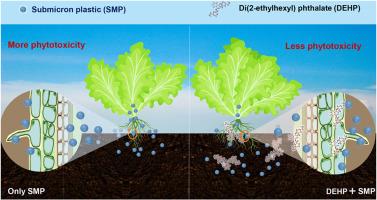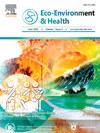邻苯二甲酸二(2-乙基己基)酯(DEHP)共暴露降低了土壤-植物系统的亚微米塑性应力
IF 17.6
引用次数: 0
摘要
农用塑料薄膜的广泛使用使得微、纳米塑料(MNPs)和邻苯二甲酸酯(PAEs)污染物成为农业生态系统日益关注的问题。然而,它们在土壤-植物系统中联合污染的相互作用机制仍然难以捉摸。为了填补这一空白,本研究调查了亚微米塑料(SMPs, 0.01%和0.1% w/w)与土壤-生菜系统中邻苯二甲酸二(2-乙基己基)酯(DEHP)之间的相互作用。与预期的协同毒性相反,DEHP显著降低了生菜根裂表面细胞对SMP的吸收(根浓度因子降低了19%-64%),即DEHP减轻了SMP诱导的氧化应激,这可以从活性氧水平(- 26.8%和- 66.7%)和抗氧化酶活性(- 118%和- 128%)的降低中得到证明。代谢组学分析显示,SMP暴露显著失调了多种代谢途径(氨基酸、碳水化合物、能量、聚糖、脂质和核苷酸代谢),而SMP + DEHP共暴露选择性地减弱了这些代谢紊乱,仅在聚糖生物合成/代谢中富集,抑制了SMP诱导的其他途径(次生代谢物的生物合成、能量代谢和信号转导)的扰动。微生物群落分析表明,高水平的SMP暴露显著降低了土壤细菌α-多样性和扩增子序列变异(ASV)丰富度,而补充DEHP提高了土壤中粘球菌的多样性和丰富度,可能抵消了SMP诱导的微生物生态失调。这些研究结果共同表明,MNPs和塑料添加剂的共同污染可能产生拮抗相互作用,而不是统一的协同效应,并为更全面地评估PAEs和MNPs对粮食安全、人类健康和生态环境的风险提供了依据。本文章由计算机程序翻译,如有差异,请以英文原文为准。

Co-exposure of di(2-ethylhexyl) phthalate (DEHP) decreased the submicron plastic stress in soil–plant system
The widespread use of agricultural plastic films has made micro- and nanoplastics (MNPs) and phthalate esters (PAEs) contaminants of emerging concern in agroecosystems. However, the interactive mechanisms underlying their combined pollution in soil–plant systems remain elusive. To fill this gap, this study investigated the interaction between submicron plastics (SMPs, 0.01% and 0.1% w/w) and di(2-ethylhexyl) phthalate (DEHP) in soil–lettuce systems. Contrary to the anticipated synergistic toxicity, DEHP significantly reduced SMP uptake into and by cracked surface cells of lettuce roots (with root concentration factors decreasing by 19%–64%), i.e., DEHP alleviated SMP-induced oxidative stress, as evidenced by reduced levels of reactive oxygen species (−26.8% and −66.7%) and antioxidant enzyme activities (−118% and −128%). Metabolomic profiling revealed that SMP exposure significantly dysregulated multiple metabolic pathways (amino acid, carbohydrate, energy, glycan, lipid, and nucleotide metabolism), while SMP + DEHP co-exposure selectively attenuated these metabolic disturbances, showing enrichment only in glycan biosynthesis/metabolism and suppressing SMP-induced perturbations in other pathways (biosynthesis of secondary metabolites, energy metabolism, and signal transduction). Microbial community analysis showed that high-level SMP exposure significantly diminished bacterial α-diversity and amplicon sequence variant (ASV) richness, whereas DEHP supplementation enhanced those of Myxococcota in the soil, potentially counterbalancing SMP-induced microbial dysbiosis. These findings collectively demonstrate that co-contamination by MNPs and plastic additives may produce antagonistic interactions rather than uniformly synergistic effects, and provide a more comprehensive evaluation of the risks of PAEs and MNPs to food security, human health, and ecological environment.
求助全文
通过发布文献求助,成功后即可免费获取论文全文。
去求助
来源期刊

Eco-Environment & Health
环境科学与生态学-生态、环境与健康
CiteScore
11.00
自引率
0.00%
发文量
18
审稿时长
22 days
期刊介绍:
Eco-Environment & Health (EEH) is an international and multidisciplinary peer-reviewed journal designed for publications on the frontiers of the ecology, environment and health as well as their related disciplines. EEH focuses on the concept of “One Health” to promote green and sustainable development, dealing with the interactions among ecology, environment and health, and the underlying mechanisms and interventions. Our mission is to be one of the most important flagship journals in the field of environmental health.
Scopes
EEH covers a variety of research areas, including but not limited to ecology and biodiversity conservation, environmental behaviors and bioprocesses of emerging contaminants, human exposure and health effects, and evaluation, management and regulation of environmental risks. The key topics of EEH include:
1) Ecology and Biodiversity Conservation
Biodiversity
Ecological restoration
Ecological safety
Protected area
2) Environmental and Biological Fate of Emerging Contaminants
Environmental behaviors
Environmental processes
Environmental microbiology
3) Human Exposure and Health Effects
Environmental toxicology
Environmental epidemiology
Environmental health risk
Food safety
4) Evaluation, Management and Regulation of Environmental Risks
Chemical safety
Environmental policy
Health policy
Health economics
Environmental remediation
 求助内容:
求助内容: 应助结果提醒方式:
应助结果提醒方式:


